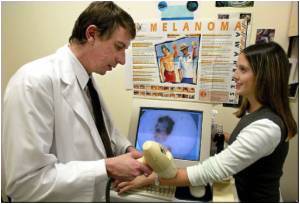US engineers have developed an ultrathin skin-like patch to monitor nerve and muscle activity.

The circuit bends, wrinkles, and stretches with the mechanical properties of skin. The researchers demonstrated their concept through a diverse array of electronic components mounted on a thin, rubbery substrate, including sensors, LEDs, transistors, radio frequency capacitors, wireless antennas, and conductive coils and solar cells for power.
Skin-mounted electronics have many biomedical applications, including EEG and EMG sensors to monitor nerve and muscle activity. One major advantage of skin-like circuits is that they don’t require conductive gel, tape, skin-penetrating pins or bulky wires, which can be uncomfortable for the user and limit coupling efficiency. They are much more comfortable and less cumbersome than traditional electrodes and give the wearers complete freedom of movement.
“If we want to understand brain function in a natural environment, that’s completely incompatible with EEG studies in a laboratory,” said Coleman, now a professor at the University of California at San Diego. “The best way to do this is to record neural signals in natural settings, with devices that are invisible to the user.”
Monitoring in a natural environment during normal activity is especially beneficial for continuous monitoring of health and wellness, cognitive state or behavioral patterns during sleep.
In addition to gathering data, skin-mounted electronics could provide the wearers with added capabilities. For example, patients with muscular or neurological disorders, such as ALS, could use them to communicate or to interface with computers. The researchers found that, when applied to the skin of the throat, the sensors could distinguish muscle movement for simple speech. The researchers have even used the electronic patches to control a video game, demonstrating the potential for human-computer interfacing.
Advertisement
“Our previous stretchable electronic devices are not well-matched to the mechanophysiology of the skin,” Rogers said. “In particular, the skin is extremely soft, by comparison, and its surface can be rough, with significant microscopic texture. These features demanded different kinds of approaches and design principles.”
Advertisement
“The blurring of electronics and biology is really the key point here,” Huang said. “All established forms of electronics are hard, rigid. Biology is soft, elastic. It’s two different worlds. This is a way to truly integrate them.”
Next the researchers are working to integrate the various devices mounted on the platform so that they work together as a system, rather than individually functioning devices, and to add wi-fi capability.
“The vision is to exploit these concepts in systems that have self-contained, integrated functionality, perhaps ultimately working in a therapeutic fashion with closed feedback control based on integrated sensors, in a coordinated manner with the body itself,” Rogers said.
Source-Medindia








